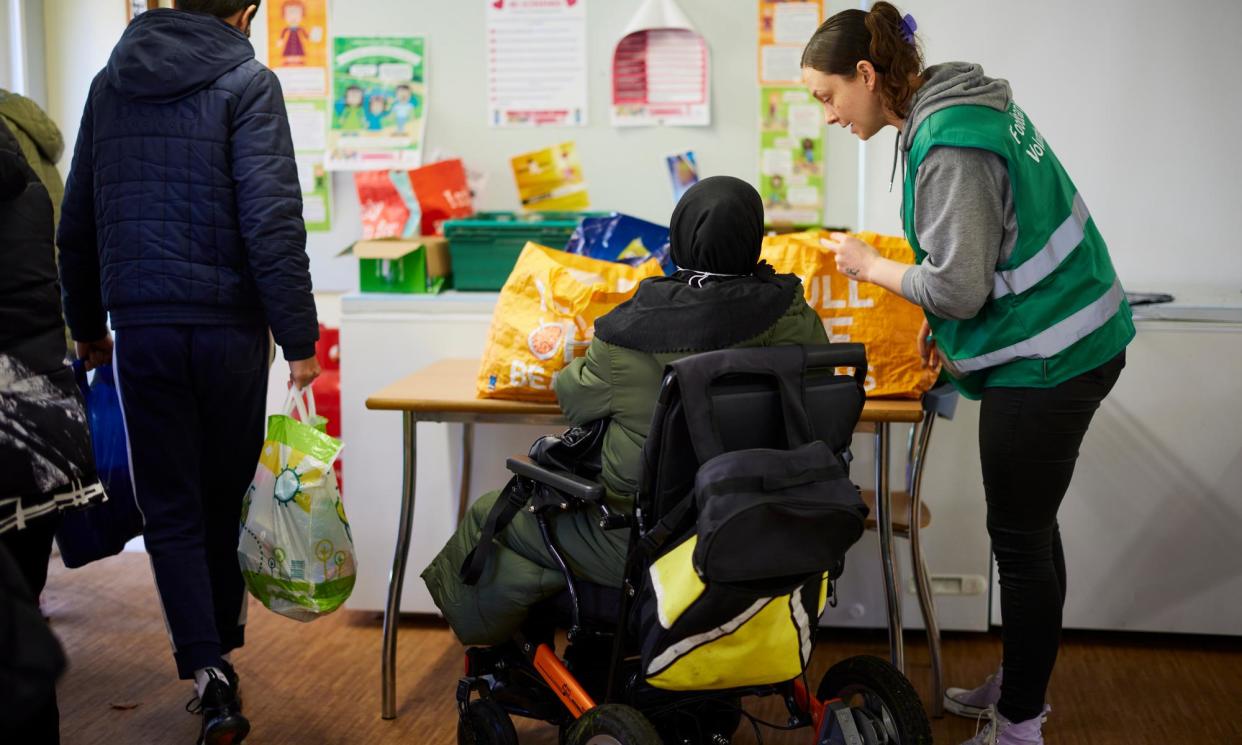300,000 more UK children fell into absolute poverty at height of cost of living crisis

About 300,000 more children were plunged into absolute poverty in a single year at the height of the cost of living crisis amid soaring levels of hunger and food bank use, official figures show, prompting calls for an overhaul of the UK’s creaking welfare safety net.
Campaigners accused the government of failing to protect the UK’s poorest families as the latest poverty statistics showed 600,000 more people fell into absolute poverty – ministers’ preferred poverty measure – in 2022-23 when inflation was at its 10% peak.
Related: UK’s poorest have borne brunt of cost of living crisis, says thinktank
Overall, during the year 12 million people were in absolute poverty – equivalent to 18% of the population, including 3.6 million children – levels of hardship last seen in 2011-12 after the financial crash.
Ministers and opposition politicians faced calls to get a grip on rising poverty levels, with charities urging an increase to benefit rates to reflect the real cost of basics, such as food and energy, and the scrapping of policies such as the two-child benefit limit which is seen as a driver of family hardship.
Campaigners said the meagreness of welfare benefits was highlighted by sharp rises in food insecurity and food bank use. One in 10 people in poverty relied on food banks during the year, while 41% of universal credit claimants were food insecure, meaning they could not afford to buy sufficient food.
The figures show the reality of increasing concerns over rising poverty, and the prevalence of more extreme forms of hardship such as destitution, where individuals are unable to afford basic living essentials such as food, energy, bedding and clothing. Nearly 4 million people experienced destitution in 2022.
The latest households below average income statistics, published by the Department for Work and Pensions, also showed that in 2022-23:
More than two-thirds (69%) of UK children in poverty lived in families where at least one parent works, while 44% of children in lone-parent families were in poverty.
An estimated 2.9 million children were in deep poverty, meaning their income was at least 50% below the poverty line. Nearly half (46%) of all families with three or more children were in poverty.
Nearly one in 10 (8%) of pensioners struggled to eat regularly, pay essential bills or keep their home warm, up 2 percentage points year on year, and the first increase in material hardship measures among the over-65s since 2014.
Child poverty also increased on the relative poverty measure that is preferred by campaigners, with 100,000 more young people pulled beneath the poverty line, meaning that a third of UK children (4.3 million) were in poverty in 2022-23 on this calculation.
Alison Garnham, the chief executive of the Child Poverty Action Group, said: “In a general election year, nothing should be more important to our political leaders than making things better for the country’s poorest kids. But child poverty has reached a record high, with 4.3 million kids now facing cold homes and empty tummies.”
The government said its cost of living support package, which included one-off cash payments and support with energy bills for low-income households, had helped alleviate pressure on poorer families and prevented more than 1 million people falling into poverty.
The work and pensions secretary, Mel Stride, acknowledged the “last few years have been tough” but claimed falling inflation coupled with a range of tax and benefit measures would provide support to people on low incomes. “The plan is working, and we need to stick to it to deliver a brighter future and economic security for everyone,” he said.
Related: There’s deepening poverty in modern Britain – but will economic growth be the solution?
Charities said the second successive annual rise in absolute poverty figures showed it had failed to do enough. “The government’s short-term interventions to date haven’t stopped the incomes of poorer households from being swallowed up by the soaring cost of essentials,” said Peter Matejic, the chief analyst at the Joseph Rowntree Foundation.
Labour called the figures “horrifying” and promised to tackle the problem if it won power at the next election. Alison McGovern, the shadow welfare secretary, said: “We’ll fix this Tory failure yet again with a new cross-government child poverty strategy.”
But the party faced renewed calls to promise to scrap the Tories’ two-child benefit limit, after the New Economics Foundation (NEF) thinktank highlighted that local authority areas in England with the biggest increases in child poverty in recent years also had high proportions of families affected by the two-child limit.
The three council areas of England with the largest rises in child poverty over the past decade (2014-15 to 2022-23), according to the NEF, were Nottingham (up 16 percentage points, with 40% of children in poverty), Birmingham (up 14 points, 41%) and Leicester (up 13 points, 41%).
Sam Tims, a senior economist at the NEF, said: “What we are seeing is a deepening of poverty in the very places that the government was supposed to lift up. The government could take millions of children out of poverty and help those in the most-deprived places by scrapping the two-child limit and increasing universal credit.”
Shona Goudie, a policy manager at the Food Foundation thinktank, said: “Current benefit levels are clearly insufficient and hugely elevate risks of food insecurity and the health consequences of eating a poor diet.”


